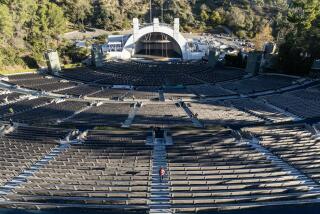Music review: Miles Davis’ works get a night out at Hollywood Bowl
- Share via
Many have revisited Miles Davis’ jazz; few have recaptured his magic. As 1980s Davis collaborator Marcus Miller observed Wednesday night, the ever-evolving trumpeter never looked back, so contemporary interpreters better keep an ear to the present.
Three ensembles picked up the gauntlet at the Hollywood Bowl, where Davis staged his last public performance in August 1991, just one month before he died.
Toughest work: Performing the entire landmark “Kind of Blue” album — an appropriate task for drummer Jimmy Cobb’s “So What” Band, since Cobb is the 1959 sextet’s lone survivor.
PHOTOS: Miles Davis remembered in sight, sound
Tall tenor saxist Javon Jackson didn’t tremble in the big loafers of John Coltrane; he swaggered through characteristic wide leaps and struck the right level of sensitivity with a bluesier tone than his predecessor. Alto man Vincent Herring’s mathematical intensity contrasted with the guttier template of Cannonball Adderley; Buster Williams’ huge bass dug deep in the earth; pianist Larry Willis pounded block chords that never would have occurred to Bill Evans or Wynton Kelly.
In ball cap and suspenders (his bandmates wore suits), Cobb uptempoed his spare groove and flailed a shake-’em-up solo. Trumpeter Jeremy Pelt kept his melancholy cool. And it grew clear that “Kind of Blue,” the ultimate lid-on simmer pot, could expand under the stars on the strength of elemental compositions such as the coasting “Freddie Freeloader” and the sensual waltz “All Blues.”
The Miles Electric Band, attacking mostly material from Davis’ festival-friendly 1969-74 period, needed to make no similar adjustments. With Davis nephew Vince Wilburn Jr. laying down the drum slosh and former Miles percussionists Badal Roy, Mino Cinelu and Munyungo Jackson jolting the appreciative audience’s spines, the Miles Electric Band quickly pumped up a party vibe.
Blackbyrd McKnight cranked wah-wah fantasies from his pink guitar; versatile trumpeter Nicholas Payton blew flame from under his purple short-brimmed hat; Robert Irving III’s sci-fi keyboard effects and DJ Logic’s turntable whooshes bounced off the hillside. The sleepy “Nefertiti” wafted attractive out-of-phase hallucinations, and at set’s end, a heavy take on the nursery-rhymy “Jean Pierre” made an apt transition to Marcus Miller’s “Tutu Revisited” ensemble.
Popping and riffing skillfully on Fender bass, Miller brought the funk with a vengeance. Although the 1980s studio period when Miller was on the team represented Miles Davis’ most insubstantial aesthetic, that era’s live concerts hauled more freight, and Wednesday’s show stacked it even deeper.
Louis Cato’s thudding rhythms, Alex Han’s passionate sax and Miller’s basic blues hooks made solid impact, building to a peak with the concluding “Tutu.” If that 1986 tune’s anti-apartheid title and the emotional meditation of “Gorée” (a Senegal port once used as a slave pen) stood at odds with their upbeat lilt, chalk it up to transcendence. But as Davis frequently demonstrated, you can tell only half the story without a healthy dose of darkness.
Miles keyboardist and independent legend Herbie Hancock, who played with the Davis Quintet at the Bowl in 1964, offered between-sets context and commentary along with screen projections. But we missed his fingers on the keys.
A new “forever” postage stamp featuring Miles Davis in iconic cobra posture was unveiled before the show; its back will feature a QR code linking his music. Beloved rebels must be acknowledged, so if you can’t lick ‘em, stick ‘em.
More to Read
The biggest entertainment stories
Get our big stories about Hollywood, film, television, music, arts, culture and more right in your inbox as soon as they publish.
You may occasionally receive promotional content from the Los Angeles Times.










